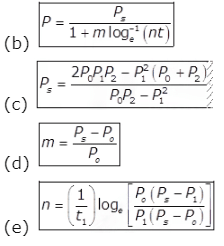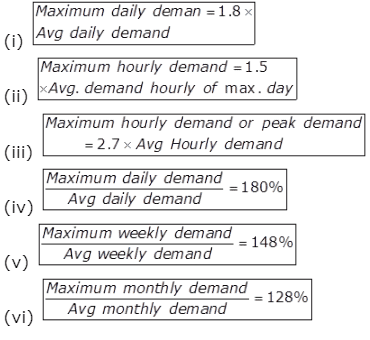Civil Engineering (CE) Exam > Civil Engineering (CE) Notes > Environmental Engineering > Water Demand
Water Demand | Environmental Engineering - Civil Engineering (CE) PDF Download
Fire Demand
Rate of fire demand is sometimes treated as a function of population and is worked out on the basis of empirical formulas:
- As per GO Fire Demand
= 100(P)1/2 - Kuichling’s Formula

Where Q = Amount of water required in liters/minute.
P = Population in thousand. - Freeman Formula

- National Board of Fire Under Writers Formula
(i) For a central congested high valued city
(a) Where population < 200000
(b) where population > 200000
Q = 54600 lit/minute for first fire
and Q = 9100 to 36,400 lit/minute for a second fire.
(ii) For a residential city.
(a) Small or low building,
Q = 2,200 lit/minutes.
(b) Larger or higher buildings,
Q = 4500 lit/minute.
(c) High value residences, apartments, tenements
Q = 7650 to 13,500 lit/minute.
(d) Three storeyed buildings in density built-up sections,
Q = 27000 lit/minute. - Buston’s Formula

The probability of occurrence of a fire, which, in turn, depends upon the type of the city served, has been taken into consideration in developing a above formula on the basis of actual water consumption in fire fighting for Jabalpur city of India. The formula is given as
Where,
R = Recurrence interval of fire i.e., period of occurrence of fire in years, which will be different for residential, commercial and industrial cities.
Per Capita Demand (q)
Assessment of Normal Variation
Population forecasting Methods
- Arithmetic increase method

Where,
Prospective or forecasted population after n decades from the present (i.e., last known census)
Population at present (i.e., last known census)
n = Number of decades between now & future.
Average (arithmetic mean) of population increases in the known decades. - Geometric Increase Method

where,
Po = Initial population.
Pn = Future population after ‘n’ decades.
r = Assumed growth rate (%).
where,
P2 = Final known population
P1 = Initial known population
t = Number of decades (period) between P1 and P2.
- Incremental Increases Method

Where, Average increase of population of known decades
Average increase of population of known decades Average of incremental increases of the known decades.
Average of incremental increases of the known decades. - Decreasing rate of growth method
Since the rate of increase in the population goes on reducing, as the cities reach towards saturation, a method which makes use of the decrease in the percentage increase, in many times used, and gives quite rational results. In this method, the average decrease in the percentage increase is worked out, and is then subtracted from the latest percentage increase for each successive decade. This method is, however, applicable only in cases, where the rate of growth shows a downward trend. - Logistic Curve Method
(a)
Where,
Po = Population of the start point.
Ps = Saturation population
P = Population at any time t from the origin.
k = Constant.
The document Water Demand | Environmental Engineering - Civil Engineering (CE) is a part of the Civil Engineering (CE) Course Environmental Engineering.
All you need of Civil Engineering (CE) at this link: Civil Engineering (CE)
|
14 videos|120 docs|98 tests
|
FAQs on Water Demand - Environmental Engineering - Civil Engineering (CE)
| 1. What is water demand in civil engineering? |  |
Ans. Water demand in civil engineering refers to the quantity of water required for various activities such as domestic use, industrial processes, irrigation, and firefighting. It is an essential factor in designing water supply systems and ensuring the availability of sufficient water resources to meet the needs of a specific area or project.
| 2. How is water demand calculated in civil engineering projects? |  |
Ans. Water demand in civil engineering projects is calculated by considering various factors such as population growth, per capita water consumption, and specific water requirements for different activities. The calculation involves estimating the water demand for each category and then summing them up to determine the total water demand for the project.
| 3. What are the factors influencing water demand in civil engineering? |  |
Ans. Several factors influence water demand in civil engineering, including population growth, urbanization, climate conditions, economic development, lifestyle patterns, and technological advancements. These factors affect the overall water consumption and usage patterns, thereby impacting the estimation of water demand for a particular project or area.
| 4. How is water demand forecasted in civil engineering? |  |
Ans. Water demand forecasting in civil engineering involves analyzing historical water consumption data, considering the population growth rate, and evaluating the impact of various factors like climate change and socio-economic conditions. Statistical models and simulation techniques are commonly used to forecast future water demand, helping in the planning and design of water supply systems.
| 5. What are some strategies to manage water demand in civil engineering projects? |  |
Ans. To manage water demand in civil engineering projects, several strategies can be adopted, including:
- Implementing water-efficient fixtures and appliances in buildings to reduce water consumption.
- Promoting water conservation practices such as rainwater harvesting and greywater recycling.
- Educating the community about the importance of water conservation and encouraging responsible water use.
- Enhancing water infrastructure and distribution systems to minimize water losses and leakage.
- Implementing water pricing mechanisms and incentives to encourage efficient water use.
Related Searches



















